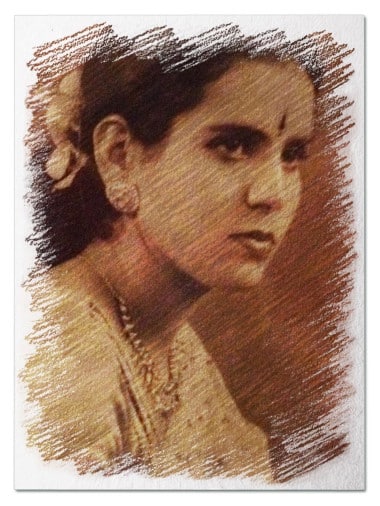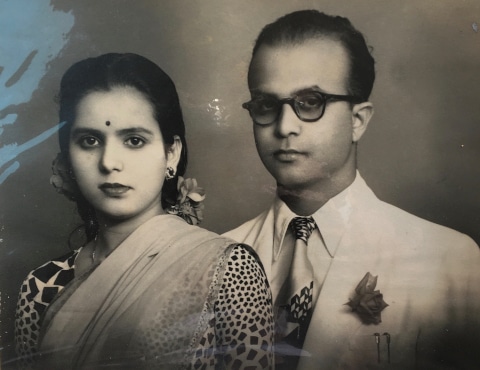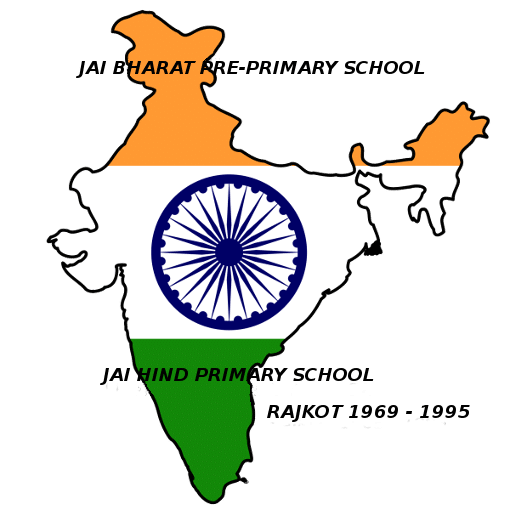PARAM PUJYA SHREEMATI VIRBALABEN
Prarthna Sabha: 19th March 2022 – Crawley Mandir: 2 -4PM
PROGRAMME

| 1 | PRAYERS | Pankajbhai Mandli | 2.00 – 2.15pm |
| 2 | TRIBUTES | Neeshatben Dalal | 2.15 – 2.25pm |
| Dr Amrutbhai Shah | 2.25 – 2.30pm | ||
| Chandrakantbhai Mehta | 2.30 – 2.35pm | ||
| Binaben Nathwani | 2.35 – 2.40pm | ||
| Jayamben Dalal | 2.40 – 2.50pm | ||
| 3 | BHAJANS | Pankajbhai Mandli | 2.50 – 3.00pm |
| 4 | GITA PRAVACHAN | Shastriji | 3.00 – 3.45pm |
| 5 | BHAJANS | Pankajbhai Mandli | 3.45 onwards |

TRIBUTE TO A VISIONARY: Jayam Dalal pays tribute to her Mother Mrs Virbalaben Prafulbhai Dalal, who peacefully passed away at the age of 89 years, on Monday 21st February 2022.
Mrs Virbalaben Prafulbhai Dalal was not only Mother to Neeshat, Bharat and Jayam – but she was an inspiration and an enterprising visionary, who was the first Indian lady to open an English Montessori School in Rajkot, India in 1969, Jai Bharat pre-primary and New Jai Hind Primary Schools.
She did her Montessori Teachers Training Course in Kolkotta in 1966, and subsequently was a teacher at Shreyas School in Ahmedabad, India – whose Founding President was Madame Maria Montessori. Subsequently when she moved to Rajkot with her family she saw a gap in education for young children, and decided to open Jai Bharat pre-primary School [the name was chosen because my name is Jayam, and my Brother’s name is Bharat].
- Door to door transport service with 3 mini buses & Ayahs in each bus to drop children home
- Home cooked sattvic vegetarian food for all students
- Large playground, and special play area with Montessori equipment and supervision
- Creative activities & after school hobby classes and tuition
- Personalised teaching
Finally it is really important to stress that none of her dreams would have been possible without the immense help and support from her Husband, and my Father Mr Prafulbhai Dalal, who never felt threatened by her intelligence or enthusiasm for education, and always supported and encouraged her to achieve her dreams. Not only that he championed and took great pride in her achievements!
A legacy website has been set up to inspire and share Mrs Virbalaben Dalal’s pioneering vision: www.jaibharatschoolrajkot.com
We have also set up a Condolence page on this website, and would very much welcome if you could share your memories of my Mother on our website.
Click on an image to see the full picture.
BHAGVAD GITA OVERVIEW
- Bhagavad Gita means “The Song of the Lord”.
- It was spoken by Lord Krsna who is considered God incarnate to his friend Arjuna just prior to the Battle of Kuruksetra. Present-day Kuruksetra is located one hundred miles northwest of New Delhi.
- The Gita as it is known, is the 6th book of the Mahabharata, which is an epic Indian tale written in Sanskrit, divided into 18 sections, and is one of the largest tales in the world. The Mahabharata is attributed to the poet Vyasa and is somewhat reminiscent of the Iliad. The great war featured in the Mahabharata is thought to have been fought around the 13th or 14th century B.C. Hindus consider this book sacred.
- James L. Fitzgerald, a professor of Sanskrit at Brown University, wrote: “simply, the Mahabharata is a powerful and amazing text that inspires awe and wonder. The most famous section of this epic is the Bhagavad Gita”.
- The scene is set on the battlefield where the Kauravas [100 brothers] are getting ready to fight their cousins, the Pandavas [5 brothers]. Arjuna is the 3rd Pandava brother and Lord Krishna is his charioteer.
- The setting of the Gita is the scene of the great battle which brings the Kauravas and the Pandavas face to face in the final trial of strength. Arjuna, the best archer of all, and Lord Krishna is his charioteer and asks him to lead the chariot to a central point, between the two arrays of hostile forces. As he surveys the field he is overcome with emotion, and the absurdity of war dominates and creates confusion in his mind.
- Arjuna seeing his kith and kin on the battlefield, loses his will to fight, not wishing to fight and kill his family members. He lays down his arms refusing to take part in this battle. The dialogue between Arjuna and Lord Krsna is the essence of the Bhagavad Gita.
- Dhrthrashtra, is the King, and also the Father of the Kauravas, is blind. Sanjay is his companion who is narrating to him the action on the battlefield as it unfolds. Sanjay has been given divine vision to see the happenings of the battlefield. The first chapter of the Bhagavad Gita starts with Drthrashtra inquiring of Sanjay the happenings on the battlefield.
- The Bhagavad Gita is a question and answer dialogue between Arjuna and Lord Krsna, whereby Lord Krsna reminds Arjuna of his duty to fight and the rights and wrongs of human frailty and shows him the path to liberation. The answers that Krishna gives him forms the 700 verses and eighteen chapters of the Gita.
- Arjuna asks a number of questions and Krishna answers all of these to remove his confusion. Free of doubt and firm in the mind, Arjuna re-enters the battlefield and emerges triumphant.
- The Gita [as it is commonly called] is considered by Hindus to be the divine essence of the Hindu Scriptures, and is the most popular scripture for Hindus around the world and is considered sacred.
- The Gita is customarily treated with great respect, and Hindus use this book to swear in Courts of Law. It is generally neither placed on the floor nor touched with the feet or dirty hands. Copies are sometimes reverently wrapped in silk cloth.
- Gita is part of the smrti (“remembered”) section of Vedic scripture [the 4 Vedas are part of the ancient Indian scriptures: Rig, Sama Yajur & Atharva Vedas] and, along with the rest of the Mahabharata and the Puranas (ancient texts), comprises what is sometimes called the “fifth Veda”. Some consider it one of the Upanishads, and it therefore goes by the name Gitopanishad.
- The message of the Gita may be viewed in two ways. The message is universal to the trials and tribulations in our daily lives. Thus the Gita is also a practical guide to a man of action and as an integral view of systems of thought. Some akin it to the five senses and the hundred distractions that face is in our daily lives, and the inner conscience that is there to guide us, if we look within ourselves to seek inner knowledge.
- The essence is ‘you have the right to perform your duty, but be free from the desire of the fruits of action’. Man should treat alike, pleasure and pain, gain and loss, devoid of passion, fear and anger. Victory and defeat will thus cease to agitate the inner spirit that engages in such action. Such a conquerer is a yogi’.
- Interestingly throughout the conversation between Arjuna and Lord Krsna, the Lord never commands Arjuna what he should or should not do. The Lord explains the consequences of each action, their result and the final outcome. The Lord then tells Arjuna in Chapter 18 – I have now explained this to you and you choose which action to take.
Some famous quotes in relation to the Bhagavad Gita include:
Mahatma Gandhi: When doubts haunt me, when disappointments stare me in the face, and I see not one ray of hope on the horizon, I turn to Bhagavad-gita and find a verse to comfort me; and I immediately begin to smile in the midst of overwhelming sorrow. Those who meditate on the Gita will derive fresh joy and new meanings from it every day.
Albert Einstein: When I read the Bhagavad-Gita and reflect about how God created this universe everything else seems so superfluous.
Henry David Thoreau: In the morning I bathe my intellect in the stupendous and cosmogonal philosophy of the Bhagavad-gita, in comparison with which our modern world and its literature seem puny and trivial
Oppenheimer famously quoted the Bhagavad Gita during the detonation of the atomic bomb on Hiroshima ‘time I am, the great destroyer of the worlds’ – chapter 11, text 32.
Aldous Huxley: The Bhagavad-Gita is the most systematic statement of spiritual evolution of endowing value to mankind. It is one of the most clear and comprehensive summaries of perennial philosophy ever revealed; hence its enduring value is subject not only to India but to all of humanity.
Carl Jung: The idea that man is like unto an inverted tree seems to have been current in by gone ages. The link with Vedic conceptions is provided by Plato in his Timaeus in which it states…” behold we are not an earthly but a heavenly plant.” This correlation can be discerned by what Krishna expresses in chapter 15 of Bhagavad-Gita.
Jayam Dalal
19th March 2022
